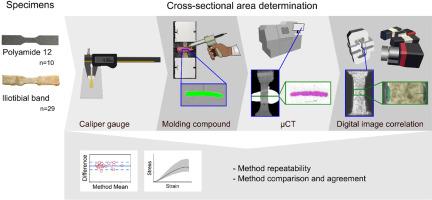髂胫束拉伸试验横截面积测定方法的准确性
IF 3.5
2区 医学
Q2 ENGINEERING, BIOMEDICAL
Journal of the Mechanical Behavior of Biomedical Materials
Pub Date : 2025-09-06
DOI:10.1016/j.jmbbm.2025.107190
引用次数: 0
摘要
在进行生物力学实验以获得有意义的特性(如极限拉伸强度和弹性模量)时,确定样品横截面积的准确值至关重要。一些研究已经研究了使用各种软组织和应用进行横截面测量的各种方法。迄今为止,缺乏对方法的比较,特别是对(人类)生物软组织的比较。本研究确定了10个合成聚酰胺12和29个人类髂胫束标本的横截面积。它采用了以下四种常用的方法:卡尺(CG)、模压复合(MC)、x射线微计算机断层扫描(μCT)和数字图像相关(DIC)。计算4种方法的重复性系数,并用Bland-Altman图比较4种方法的一致性。除CG外,所有方法均可提供一致可靠的髂胫束横截面测量,其性能水平无差异。在聚酰胺样品中,μCT横截面测定可提供最佳的重复性系数RC (0.09 mm2和0.18 mm2,体素分辨率降低)。它还显示髂胫束标本的最佳一致性,特别是与MC相比,偏差小于1%,一致性限制低于±25%。结果表明,μCT、MC和DIC三种方法均可有效地用于软组织的CSA测量。仅在几何高度均匀的标本中观察到较小的方法学差异。主要的限制因素似乎是固有的组织特异性变异性,而不是应用系统的测量精度。相比之下,由于系统偏差和与所有其他研究方法的一致性较差,CG不能被推荐用于软组织标本的准确CSA测定。本文章由计算机程序翻译,如有差异,请以英文原文为准。

Accuracy of cross-sectional area determining methods for tensile testing of iliotibial band
Determining accurate values on specimen cross-sectional areas is crucial when conducting biomechanical experiments in an effort to derive meaningful properties such as ultimate tensile strength and elastic modulus. Several studies have investigated various methods for cross-section measurements using various soft tissues and applications. Comparison between methods is missing to date especially for (human) biological soft tissues.
This given study determined the cross-sectional areas of ten synthetic polyamide 12 and twenty-nine human iliotibial band specimens. It used the following four commonly deployed methods: caliper gauge (CG), molding compound (MC), X-ray micro computed tomography (μCT) and digital image correlation (DIC). The repeatability coefficient was calculated for the four methods and the agreement between the four methods were compared using Bland-Altman plots.
All methods but CG offer consistent and reliable measurements of iliotibial band cross section determination, with no difference in their performance levels. In the polyamide specimens, cross-section determination using μCT appeared to provide the best repeatability coefficient RC (0.09 mm2 and 0.18 mm2 with reduced voxel resolution). It shows also for iliotibial band specimens the best agreements especially when compared to MC with a bias less than 1 % and limits of agreements lower ±25 %.
The given data suggest that any of the given methods, μCT, MC or DIC can be used effectively for CSA measurements of soft tissues. Minor methodological discrepancies were observed exclusively in specimens with highly uniform geometries. The principal limiting factor appears to be inherent tissue-specific variability rather than the measurement precision of the applied systems. In contrast, due to systematic bias and poor concordance with all other methods investigated, CG cannot be recommended for accurate CSA determination of soft tissue specimens.
求助全文
通过发布文献求助,成功后即可免费获取论文全文。
去求助
来源期刊

Journal of the Mechanical Behavior of Biomedical Materials
工程技术-材料科学:生物材料
CiteScore
7.20
自引率
7.70%
发文量
505
审稿时长
46 days
期刊介绍:
The Journal of the Mechanical Behavior of Biomedical Materials is concerned with the mechanical deformation, damage and failure under applied forces, of biological material (at the tissue, cellular and molecular levels) and of biomaterials, i.e. those materials which are designed to mimic or replace biological materials.
The primary focus of the journal is the synthesis of materials science, biology, and medical and dental science. Reports of fundamental scientific investigations are welcome, as are articles concerned with the practical application of materials in medical devices. Both experimental and theoretical work is of interest; theoretical papers will normally include comparison of predictions with experimental data, though we recognize that this may not always be appropriate. The journal also publishes technical notes concerned with emerging experimental or theoretical techniques, letters to the editor and, by invitation, review articles and papers describing existing techniques for the benefit of an interdisciplinary readership.
 求助内容:
求助内容: 应助结果提醒方式:
应助结果提醒方式:


